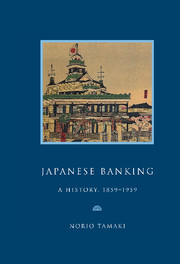Book contents
- Frontmatter
- Contents
- Preface
- Genealogy of leading Japanese banks, 1859–1959
- List of abbreviations
- Map
- Part I A bankrupt Shogunate, 1859–1868
- Part II The Meiji Restoration: monetary confusion and banking experiments, 1868–1881
- Part III Matsukata, the wizard of Japanese banking, 1881–1897; the Yokohama Specie Bank (1880) and the Bank of Japan (1882)
- Part IV The Japanese on the London money market, 1897–1911
- Part V War, the Japanese boom years, 1911–1919
- Historical background
- 17 Bank of Japan money supply, 1911–1919
- 18 The expansion of special banking, 1911–1919
- 19 Ordinary and savings banks, the search for strength, 1911–1919
- 20 Other financial sectors in the boom years, 1911–1919
- Part VI Crisis and the road to war, 1919–1937
- Part VII Complete commitment, struggle and defeat, 1937–1945
- Part VIII American ‘democratisation’ and the search for growth, 1945–1959
- An extraordinary century, 1859–1959
- Appendices
- Notes
- Bibliography
- Index
20 - Other financial sectors in the boom years, 1911–1919
Published online by Cambridge University Press: 03 February 2010
- Frontmatter
- Contents
- Preface
- Genealogy of leading Japanese banks, 1859–1959
- List of abbreviations
- Map
- Part I A bankrupt Shogunate, 1859–1868
- Part II The Meiji Restoration: monetary confusion and banking experiments, 1868–1881
- Part III Matsukata, the wizard of Japanese banking, 1881–1897; the Yokohama Specie Bank (1880) and the Bank of Japan (1882)
- Part IV The Japanese on the London money market, 1897–1911
- Part V War, the Japanese boom years, 1911–1919
- Historical background
- 17 Bank of Japan money supply, 1911–1919
- 18 The expansion of special banking, 1911–1919
- 19 Ordinary and savings banks, the search for strength, 1911–1919
- 20 Other financial sectors in the boom years, 1911–1919
- Part VI Crisis and the road to war, 1919–1937
- Part VII Complete commitment, struggle and defeat, 1937–1945
- Part VIII American ‘democratisation’ and the search for growth, 1945–1959
- An extraordinary century, 1859–1959
- Appendices
- Notes
- Bibliography
- Index
Summary
The war boom stimulated every sort of institution which was in any way involved with money and banking in Japan. Post offices which had operated for a long time, almost since 1868, were by 1900 holding, in the form of small savings, the equivalent of 10 per cent of total banking deposits. These moneys were in effect kept in the trust fund department of the Finance Ministry. They continued to increase in the early 1900s and throughout the war boom. Indeed by 1919, post office savings became the largest resources for direct government needs, amounting to ¥731 million, equivalent to nearly 13 per cent of the total banking deposits.
Another kind of organisation, also important in gathering small savings, was the mujin, or mutual loan associations. Already during the first decade of the twentieth century, mutual loan business was progressing and some organised themselves into company form. In 1914 approximately 830 companies with ¥9.6 million paid-up capital were operating. The Finance Ministry determined to set guidelines for mutual loan business in order to protect subscribers and to ensure that their resources were secure. The result was the Mutual Loan Business Act of 1915 which stipulated that the mutual loan company should have a minimum of ¥30,000 nominal capital of which more than half was to be paid in. Subscribers were required to pay instalment money regularly and the company could lend part of the money by lottery, allowing those subscribers who wished to draw lots.
- Type
- Chapter
- Information
- Japanese BankingA History, 1859–1959, pp. 134 - 136Publisher: Cambridge University PressPrint publication year: 1995



